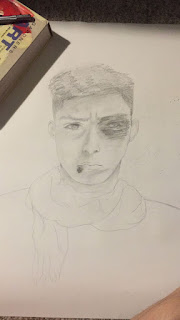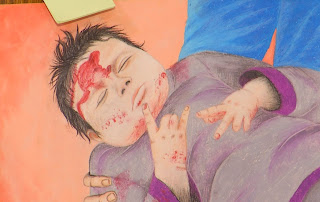https://www.youtube.com/watch?v=LJPk8-zl_Gs
SCRIPT: (not exact, I added some things as I talked)
Hello! My name is Naz Hussein and I have finally finished my final project! Now, for the creative critical reflection, I will begin outlining the research process and the inspiration for my project. Of course, executive order 13769 by President Trump to ban refugees was extremely controversial and affected me as a native of Iraq. At the beginning of my journey, I had not considered my piece to be that of a political statement. Like the magazine I created in the AS Level, I wanted to focus on a more artistic expression. When I visited Vizcaya Museum& Gardens in Miami, I was utterly inspired by the beauty and the location, so I decided that I wanted to film the majority of my footage in Miami. It started out as an idea of showing the beauty and diversity of Miami; however, I was soon taken aback by the order and wanted it to focus on the hardships of an immigrant artist. What inspired me mainly was an article from New York Times detailing the hardships of couples being separated because of the ban. When I read this, I immediately wanted to create a film that caters to an emotional and more humane side of the conflict. This idea was more of a personal inspiration since Arabs especially are so ill portrayed in the media. Prior to starting on the final project, I had extensively researched the portrayal of Arabs in the media, especially Hollywood. There’s a documentary called Reel Bad Arabs: How Hollywood Vilifies a People based on the book by Jack Shaheen that goes in depth on a very negative portrayal of Arabs: they are terrorists, sexists, uncivilized, and anti-Semitic. Moreover, the news nowadays only presents Arabs as a struggling people plagued by war and stuck trying to escape their homeland. Those pictures are very often seen on television and have almost been branded in the Western hemisphere’s mind. Yet, I wanted to show a different side, to break conventions of representation. I wanted to portray the Arab who has experienced trauma as an actual human being with aspirations and passions, so I decided to visit the Iraqi artist. This representation of the Arab social group is very much a deviation from standard representations; yet, my main character, Adnan, is also lonely and estranged. He is awed by the freedom and safety that is present in Miami, along with the beauty of expression. Even so, all of this is broken when the travel ban is instituted and he can no longer see his family, who was bound to follow him. I also used many conventions; however, a very important one: the main trailer and the teaser trailer. It is a convention I often see and from a marketing aspect, it fairly works. The teaser is a shorter trailer that does not specifically outline the plot of the film. It just shows the highlights and clips from the movie. I embarked on research to discover this, as I have detailed in my blog. Allied, a recent film, utilized many of the same clips in both the main and teaser trailer. This is an important fact to not give away the film to the audience. I have also used the convention of the black screen during the main trailer that moves the trailer along, giving snippets of the story. A convention I broke is that I did not use dialogue so much to move the trailer. The trailers only show one actor: this film is more focused on a character and his development. This was more convenient for the limited period of time I had to create this project; plus, I really only had one actor to work with (everyone’s schedule was extremely difficult to work around.) Even so, it worked well with my message since I wanted to focus on the humane side and hardships of someone’s estrangement. Being stranded in a place where your natives are banned for is quite difficult: how will you react? How will you resist? Will you even resist at all?
The elements of my production create a sense of branding in 3 ways:
-The font used for the outlaw is unique and eye grabbing
-Artistic
-For millennials
How is this done? My trailers all show the artistic side of Adnan. My slogan or catch phrase for the film is “Fight with Art”, and this is included in my poster. My website includes the art blog where Adnan supposedly posts his reform to, and I included this on a Tumblr blog specifically since this film targets millennial specifically. this other aspect of my branding, towards millennial, is seen with the young age of the main character and the controversial issue of the ban that millennial social activists are tackling. This is not just a movie for the social activists but for the whole millennial generation since they are all aware of the growing social activist sentiments among the group. Also, the font used for the Outlaw Title has been reiterated in all of my pieces and has the sense of the new growing passionate drive for reform and change.
My products engage with the audience through the catchy color of the poster. The name of the film too is extremely engaging and intriguing: it brings on a mystery. Yet, what i think creates the most engagement is the controversial topic itself of the ban: it’s still a “hot topic”, so it is bound to attract people from any ideology. Another thing id like to point out is how my teaser trailer features sad, emotional music to make the film look dramatic and engaging in a way that develops the character. Music helped me a lot too through this process, and id like to thank Ross Bugden, a young composer who shares his music for royalty free. Without him, I don’t know where I would find such beautiful music to incorporate into my trailers: for the main one, the music created the suspense and the high and falls of the typical trailer music but not to the extreme degree that action movies are done.
As real media products, I would very much like to focus on more contemporary, technological ways to target the millennial audience. No more flyers or TV ads: I mainly want it to be online and social media based. I placed a huge emphasis on the social media follow on my website because I am aware of the active status of most millennial on such websites. Nowadays, most millennials use Snapchat, Instagram, and twitter. Even though Facebook is still a main social media site, it is failing with the younger millennial generation. Thus, I want to have ads on Snapchat and Spotify, a very popular music application. I also want my social media websites to be extremely engaging and have different techniques to keep up with the audience: for example: Trivia of the day! Poll of the day! What do you guys think? 500 Retweets and we’ll post a sneak peek! Those are the most effective methods to engage with the generation nowadays. Of course, I still want it to be on Facebook as well as on television, but more so the other, more technological aspects.
I integrated different technologies for this project, for the
- Hardware, I used a Tripod, Camera, and Mise-en-scene elements. Those elements were important for setting up the location and appearance of the footage, they are also obviously essential to filming. For example, when we went to Wynwood, I asked Alexis to dress more “artistic” and colorful. But when we went to the airport, I asked him to look more professional with neutral colors: green and black pants. I also utilized my locations carefully: I went to the Miami Airport to film the airport scenes, as well as Wynwood Art District and Lincoln Road in Miami. I fulfilled my initial dream of incorporating a lot of the beauty and diversity of Miami within the film.
- I used Final Cut Pro to edit my trailers, as well as After Effects to create the black screen with text for the trailers. What was so difficult about After Effects is that everywhere I looked for tutorials, no one explained the simple concept of Scaling, which is what I needed. As you can see here, this is how I created it: I added the text with some simple effects and scaled it so that it would progressively get smaller as time went by. I also used Photoshop extensively for the Movie Poster and looked for tutorials to better my experience: like for example, the Patch Tool and the Spot Healing Brush Tool were extremely helpful since my background had many botched and spots I wanted to remove. I also used Photoshop to edit pictures I used for my website. Finally, I also used Quicktime Player to of course, play the videos and also record this screencast for the CCR.
- Online: The most important aspect of this project was the amount of research done online. I initially researched many articles about the ban. What also inspired me tremendously is the presence of social activists on Twitter. I know that many, older individuals frown upon this idea of “fake news”; however, I don’t specifically look at the news they spread but their point of views. I’ve been lost in the course of this election on where I stand on my political views as a native of Iraq living in the US; however, there are many users on Twitter who speak up pridefully and share interesting point of views which I then go to research online and find factual evidence of. Of course, this was an indirect correlation to my project, but this helped fuel my idea and my desire to portray such a difficult and controversial idea in the first place.
- what also helped me online are font websites that I searched very meticulously to find perfect fonts. Also, tutorials to use all of the software were helpful, especially simple tasks that weren’t so evident within the application, like how to render the video on Final Cut Pro, or press Command D to deselect a selection on Photoshop (which was honestly driving me insane).






























